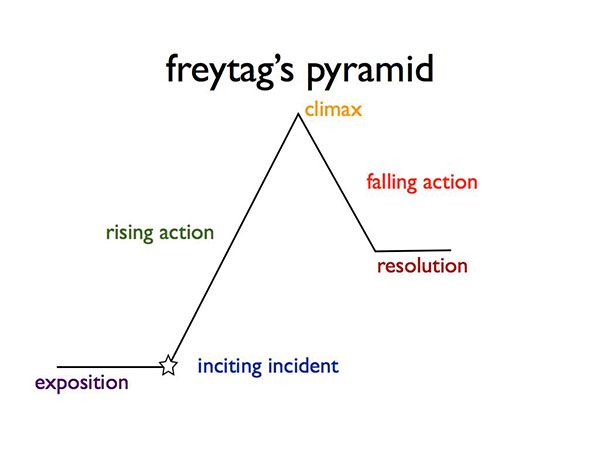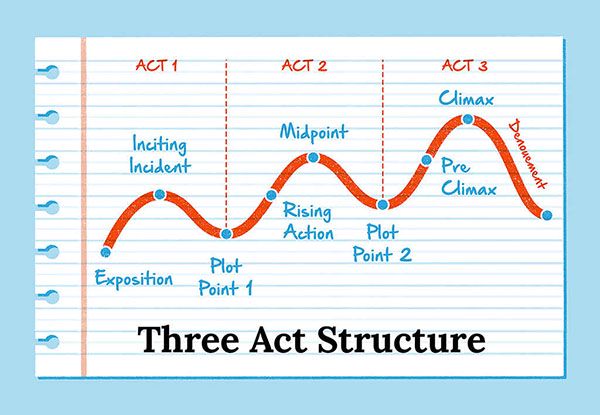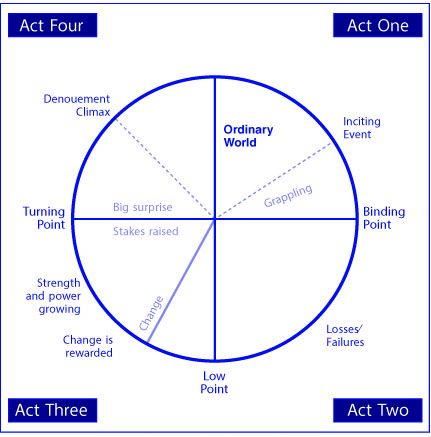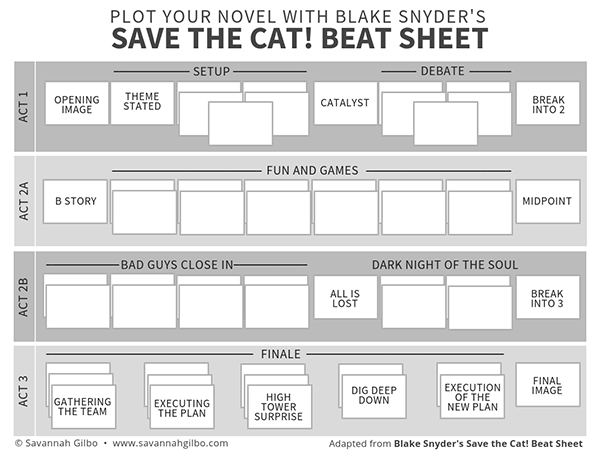Outlining Your Plot...or Not

"Is this a dagger which I see before me,
The handle toward my hand? Come, let me clutch thee.
I have thee not, and yet I see thee still.
Art thou not, fatal vision, sensible
To feeling as to sight? or art thou but
A dagger of the mind, a false creation,
Proceeding from the heat-oppressed brain?" Macbeth by William Shakespeare

The Plot is a sequence of events that make up a story and how they relate to each other. Believe it or not, the plot differs from the story in one key way; a story is a narrative of events arranged in their time-sequence, while a plot highlights a specific and purposeful cause-and-effect relationship between the sequence of events. For example: The king died and then the queen died, is a story. The king died and then the queen died of grief, is a plot.
To successfully convey a story's plot, you need to structure it into parts. This process will ultimately give you the story arc (or the narrative arc). In order to find that arc, it is helpful to create an outline. Check out The Story Arc chapter in this guide for details about story arc.
There are two main types of writers: the plotters and the pantsers. The plotters outline their story before writing it, and the pantsers start writing and let the story unfold organically (they fly by the seat of their pants). There are pros and cons to each. And some like to find a middle ground; the plantsers. Have you decided where your writing style falls?
Stay with us and hopefully we can help you find your happy writing place.

PLOTTERS
There are various methods for outlining a plot. Some use the three act method, some prefer four acts, and some like to keep track with a beat sheet. The following is a list of commonly used outlining methods:
Freytag's Pyramid - German novelist, Gustav Freytag, used a pyramid to put forward the idea that every arc goes through five dramatic stages: exposition, rising action, climax, falling action, and resolution.

Three Acts - As basic as you can get; beginning, middle and end.
Act 1 = Setup (plot part = inciting incident)
Act 2 = Confrontation (plot part = midpoint)
Act 3 = Resolution (plot part = climax)

Four Acts - The four-act structure is a slightly less typical (but no less efficient) narrative model and is common for screenplays. Using four acts instead of three, the Plot Clock helps to amp up the tension by encouraging the proper number of external events, twists and turns. Most of all, it provides a 'map' for writers lost in that long, sagging middle.

Beat Sheet - Also used in film making, a story beat refers to a single story event which transforms the character and story at a critical juncture. Think of beats as checkpoints along the way, charting a film or novel's structure and completing the story.


THE OUTLINE
An outline includes important information about your story's structure, plot, characters, scenes, and more. It is the skeleton of your novel. An outline can be anything from a one-page written document to a comprehensive visual mind map that uses diagrams to link information and ideas. If you have the space, you can write significant plot events on index cards to make it easier to view and manipulate. Some writers use a white board, while others find that beat sheets work just fine.
Three questions to answer in your outline:
◾What is the main contract (promise) of the story? You must resolve the promises you made to your reader by the end of the novel.
◾What sort of time pressure is working on your characters?
◾What is at stake for the protagonist of the novel? Do these stakes rise as the story progresses?

THE PROCESS
Craft Your Premise: This is the underlying idea for your story. A good way to find the premise is to ask yourself, "What would happen if...?" For example: What would happen if a young man who survives a shipwreck spends months in a lifeboat with a large Bengal tiger? (Life of Pi, 2001)
It might help to answer a few key questions to expand on the premise and generate new ideas: Who is the main protagonist? What do they want? Is there an opposing force keeping them from what they want? How do they change from the beginning of the story to the end?
Determine Your Setting: Time and place can be just as important as the characters and are dependent on the type of story you're telling. Do as much research as you can. If your novel is set in the real world, find photos and descriptions to bring your ideas to life, even down to the details of how something might smell, taste, feel or sound.
Get To Know Your Characters: Write character profiles. Visualize them. Pretend you're introducing them to your friends. What would you say about them? What details would you include, and what details would you omit—and why? What kind of journey will each character undertake in the novel? Where will they start, and where will they end up?
Write character backstories. Think of the moments in each character's life that led them to the point where they are introduced. What elements have shaped their personality? Do they have unresolved issues that are crucial to the plot?
Construct A Plot Timeline: Write down everything that happens in the story from beginning to end. Where do events take place, and who is involved. Include the outcome of events and how they will impact the story's overall plot, if you know this already. These can help form the foundation of additional subplots.
Write Your Scenes: Once your plot outline is in place, you'll have a better idea of scene structure and where they should be placed. Some writers do this with their chapters. Flesh them out—everything from where the action takes place to who is involved, even dialogue if you know what you want your characters to say. Don't worry about things making sense, you'll go back later and highlight anything that feels out of place.
Done and Done: Once your outline is complete, you can start writing your first draft with the knowledge that if you falter, you have an outline to refer to.

Why not write a synopsis?
Now that you've finished rolling your eyes, we will explain why writing a synopsis during the outlining process is beneficial. If you are planning to send your novel around to agents and publishers, you will have to write a synopsis at some point anyway.
Because a synopsis is written in chronological story form, it is more informal than an outline and can feel like free-writing. It's often a liberating exercise that allows you to let go, not worrying about broader story structure. You can include notes to yourself to work out parts you aren't entirely sure about yet. Just get the bulk of the storyline written and worry about making it publisher-ready later.

Plotting Pros and Cons
Pros: Plotters, having planned out their novel ahead of time, know what's going to happen before they write it. This makes it easier to bust writer's block. Plotters know their characters and what those characters are capable of. They also tend to finish their novels faster, or at least more efficiently.
Cons: Plotters can become rigid and confined to their plans, leaving less room for their characters to venture off the path. When this happens, the writing can sometimes feel bland and formulaic.

PANTSERS
One of the main reasons pantsers prefer their style of drafting stories is they believe it opens them up to creativity without being inhibited by a rigid outline. Pantsers don't know what the road looks like ahead, so they can take a right, a left, or go off-roading if they want to.
Of course, the one thing about traveling without a map (or GPS) is that it's easier to get lost or find yourself at a dead end. As such, pantsers are more prone to rerouting or backing up in order to move forward with the story again. But writers are a resilient breed, and there is always a solution to be had.

Zero Draft, or The Pantser's Compromise
If you prefer to write by the seat of your pants, there is a kind of plot outline you may find useful. This is called a zero draft or discovery draft (e.g. you're just discovering the story and characters). In fact, this draft is too unstructured to even count as a first draft.
Ideally, the zero draft is written quickly to give only the roughest idea of what should occur, when it occurs, and who it's happening to. It's perfectly acceptable to skip entire scenes or sections of the story and leave notes in their place. The zero draft is great if you struggle writing outlines but you often get stuck when writing a story without the safety net of one.

Pantsing Pros and Cons
Pros: Pantsers have the freedom to take their story in any direction they want to. If they don't like a character, they can kill him. If they don't like the way their plot is going, they can change it. They have complete flexibility.
Cons: Having no plan, or very little plan, makes it easier to get stuck. If a pantser gets stuck, they must come up with a way to dig themselves out of that huge plot hole they didn't see coming. When this happens, pantsers often abandon old projects for new ones, leaving multiple unfinished novels in their wake.

You Could Be A Plantser!
Some people call themselves "plantsers", which means they're part plotter, part pantser. In reality, most people are plantsers, leaning more to one side or the other. Wherever you lean, the important thing is to finish that novel. And a little direction never hurts.
Bạn đang đọc truyện trên: AzTruyen.Top